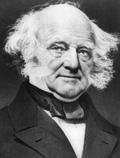 |
Martin Van Buren
b. 5 Dec 1782, Kinderhook, Columbia County, New York
d. 24 Jul 1862, "Lindenwald," Kinderhook, Columbia County, New York |
| Title: |
President of the United States |
| Term: |
4 Mar 1837 - 4 Mar 1841 |
| Chronology: |
8 Feb 1837,
the election to the office of the President of the United States is declared upon the ascertainment and counting of the electoral vote (cast 7 Dec 1836),
joint session of the Senate and the House of Representatives, House Chamber, U.S. Capitol, Washington, D.C. [1] |
|
4 Mar 1837,
commencement of term |
|
4 Mar 1837,
took the oath of office as the President of the United States, inaugural ceremony as part of the special session of the Senate, East Portico, U.S. Capitol, Washington, D.C. [2] |
|
4 Mar 1841,
expiration of term |
| Biography: |
| Eldest son of a small farmer; studied the rudiments of English and Latin in the schools of his native village; at the age of 14 years commenced reading law; in 1802 he went to New York City and studied law with William P. Van Ness, a friend of Aaron Burr; admitted to the bar (1803) and commenced practice in Kinderhook, New York; moved to Hudson, New York, in 1809; surrogate of Columbia County (1808-1813); member, New York State senate (1813-1820); attorney general of New York (1816-1819); delegate to the State constitutional convention in 1821; elected to the US Senate; reelected in 1827, and served from 4 Mar 1821, until 20 Dec 1828, when he resigned, having been elected Governor; chairman, Committee on the Judiciary (18th through 20th Congresses); elected Governor of the State of New York (3 Nov 1828, election is certified 5 Dec 1828) and briefly occupied that office (1 Jan 1829 - 12 Mar 1829); resigned to enter the Cabinet; appointed Secretary of State (28 Mar 1829 - 23 May 1831) in the Cabinet of President Andrew Jackson; resigned when he was commissioned Minister to Great Britain; the Senate rejected his nomination in January 1832, and he returned to the United States; elected, as a Democrat, Vice President of the United States on the ticket with Andrew Jackson and served from 4 Mar 1833, to 4 Mar 1837; elected, as a Democrat, President of the United States in 1836; took office as a financial panic spread throughout the nation; removed government funds from state banks and put them in an "independent treasury"; costly war with the Seminole Indians in Florida; unsuccessful candidate for reelection as President on the Democratic ticket in 1840 and on the Free-Soil ticket in 1848; withdrew from political life and retired to his country home, "Lindenwald," in Kinderhook, New York, where he died. |
| Biographical sources: Biographical Directory of the United States Congress (2005). |
| Elections: |
| Candidate |
Electoral vote (7 Dec 1836) * |
| |
including votes from Michigan |
excluding votes from Michigan |
| Martin Van Buren |
170 |
167 |
| William Henry Harrison |
73 |
73 |
| Hugh Lawson White |
26 |
26 |
| Daniel Webster |
14 |
14 |
| Willie Person Mangum |
11 |
11 |
| total number of electors appointed |
294 |
291 |
| number of votes for a majority |
148 |
146 |
|
| * Michigan appointed electors who cast their votes before the state was admitted to the Union 26 Jan 1837. Anticipating a challenge to the results, the Congress passed a Concurrent Resolution (4 Feb 1837), requiring to declare the results "were the votes of Michigan to be counted" and "if not counted" (Congressional Globe, 24th Congress, 2nd Session, 151-153).
|
| Source of electoral results: Register of Debates, 24th Congress, 2nd Session, 1656-1657; House Journal, 24th Congress, 2nd Session, 358-359.
|
| |
| [1] |
Register of Debates, 24th Congress, 2nd Session, 1655-1658; House Journal, 24th Congress, 2nd Session, 343, 357-360; Congressional Globe, 24th Congress, 2nd Session, 152, 167. |
| [2] |
Senate Executive Journal, vol. V, 1-11. |
|
Image: photograph of Martin Van Buren (created between 1840 and 1862), Library of Congress Prints and Photographs Division, Washington, D.C. |

